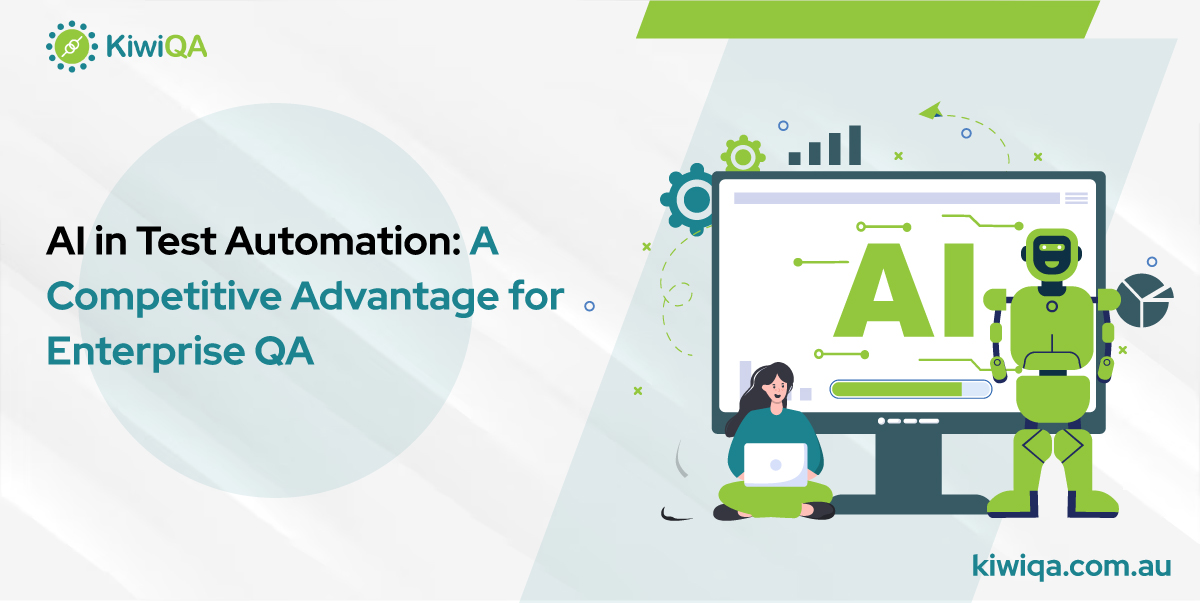AI in Test Automation: A Competitive Advantage for Enterprise QA

 KiwiQA
KiwiQAWith AI enabling test automation, a new revolution is taking place in QA almost everywhere. Beyond basic scripting, it provides smarter, faster, and more accurate means to verify the software’s reliability. Test case generation is perhaps its strongest capability. It takes AI in test automation the form of requirements, code structures, and user flows to automatically generate optimized test cases. Additionally, it helps with advanced defect prediction models to detect anomalies before they become critical failures.
Since AI can analyze test results and identify potential problems, it can save breakdown problems that manual tests would have missed. In the quest for trustworthy software test automation services, artificial intelligence is the definitive game changer that transposed traditional testing strategies to a strategic business advantage. This evolution isn’t merely about efficiency; it’s about creating sustainable competitive differentiation through smarter, more predictive quality assurance practices.
Considering the rate at which digital transformation is impacting enterprises to deliver solid software faster and in a better way, it simply means they can’t and won’t stop. The pressure has never been greater to release flawless applications while doing so at lightning speed. Also, QA has come out of the back office and established itself as a strategic enabler that plays a direct role in business outcomes and customer satisfaction.
Look into AI: the new disruptive wave in the enterprise QA horizon. Artificial intelligence is bringing big changes to testing by allowing for smarter, self-improving testing systems, not just simple automated ones. Since this shift has been noticed by leading software test automation companies, they have started adding AI-driven capabilities into their offerings.
AI in software test automation is not just about an efficiency upgrade; it is about putting real, measurable competitive advantages in front of the enterprises. This is why organizations using AI-driven automated testing have a distinct competitive advantage over speed, quality, cost efficiency, and strategic insight. AI is now used by nearly 8 out of 10 software testers to increase their productivity. This growing trend highlights how AI tools are becoming vital in speeding up workflows and cutting down on manual testing.
Also Read: Top 5 Software Testing Companies in Australia
Quality assurance, in turn, provides for competitive advantage in several critical dimensions and directly influences business performance:
❖ Faster time-to-market: AI-based testing speeds up the delivery pipeline, and organizations can release new features and fix bugs faster than their competitors. In industries where being first yields big market opportunities in the form of revenue streams, this speed advantage is especially important.
❖ Superior product quality and customer experience: Based on the development of more reliable products, companies implementing AI in automation testingachieve superior product quality and customer relations. Moreover, it also adds to the brand trust and high levels of customer retention rates.
❖ Operational efficiency and scalability: AI-based test automation dramatically enhances test efficiency, wherein the QA teams can fulfill the requirement of increasing testing load without any corresponding increase in resources or costs. This, in turn, allows business growth at a fast pace without affecting quality.
❖ Early issue detection and prevention: The use of AI to predict defects before they even occur saves QA from being a reactive exercise to a proactive one. Moreover, this preventive approach is the reason why fixing problems can be so much cheaper than fixing them after they are released.
AI enables smart testing rather than just fast testing. On the other hand, traditional automation is so fast but not smart enough to respond to changing conditions or pick up from the results of previous tasks. On the contrary, AI-driven test automation keeps getting better by analyzing patterns, predicting issues, and optimizing test coverage.
From a technological viewpoint and a commercial standpoint, groups must observe how well artificial intelligence functions. Model accuracy, response time, and user satisfaction should be watched on a periodic basis. When performance slips or needs change, quick adjustments are key. A constant retraining of models, feature tweaking, or system reconfiguring keeps everything in line with business goals.
This is fundamentally about risk anticipation, history learning, and cycle improvement. Every test execution generates valuable data that AI systems use to refine their testing strategies. As a result, AI-powered QA becomes increasingly precise and efficient over time, creating a widening competitive gap between organizations that employ such systems and those that don’t.
It helps to develop a timeline and budget. Breaking the project into stages, like data collection, model building, and testing, makes it easier to stay organized. Setting realistic timeframes for each of the stages will keep the project on track. Even the best AI model only reflects as much of the data that powered it. Accurate predictions are backed by high-quality data.
Before your data engineering design constitutes, start with relevant data sources, whether from internal systems, sensors, or third-party providers. Secondly, cleaning data, getting rid of the extra errors, duplicates, and any irrelevant details, makes sure that it is ‘ready for analysis.’ Teams must then work out what kind of setup the AI solution needs.
For instance, the deep learning models might require high-power GPUs, whereas some of them can work on general-purpose systems. Either way, it must be strong, secure and reliable. The system should provide consistent performance with no unexpected outages, and data privacy should be built into it.
Parallel run of multiple tests leads to dramatic cuts in test cycle times. It frees teams to work on strategic work rather than repetitive work. This is a massive boost to total development speed. Every code path is traced by smart algorithms in order to increase the reliability of results. The outcome? Higher-quality software with fewer defects.
It can be easily seen that there is an evolution in methodologies of testing: Manual Testing → Automated Testing → Intelligent AI-Driven Testing. Yet, no application is ever complete. For every application to work correctly, securely, and efficiently, it has to have complete coverage. Systems are always at risk when skipping tests or relying only on manual testing.
Manual testing only relied on human judgment, and traditional automation exclusively executed the script repeatedly; however, automation testing with AI is an intelligent level that makes decisions, learns from the outcomes, and improves testing strategies through continuous optimization.
Yet manual testing alone falls short. Writing test cases takes time. Tracking code changes and updating tests accordingly is tough. Edge cases, those rare but impactful situations, are often missed by human testers. It’s no wonder that developers and QA teams struggle to keep up with today’s fast-paced releases. Traditional automation approaches face significant limitations in large-scale enterprise environments:
❖ Script maintenance becomes overwhelming as applications evolve. AI can track code changes and intelligently update related test cases. It actively examines client conduct and past defect data to predict elevated danger zones. Once identified, these areas become priorities for testing, helping teams find issues before they reach customers. That proactive approach boosts software quality and gives teams a head start on maintenance.
❖ Test coverage gaps persist as human testers can’t anticipate all scenarios. When teams bring data into their QA processes, they can make smarter decisions every step of the way. Predictive analytics helps forecast test results and surface trends. Teams can anticipate issues, plan accordingly, and apply root-cause analysis to eliminate recurring defects. Over time, this builds stronger processes and better outcomes.
❖ Test data management grows exponentially complex. AI executes test cases at a pace no human can match. Multiple tests run in parallel, cutting test cycle times dramatically. That frees up teams to tackle strategic work instead of repetitive tasks. It’s a huge boost to overall development speed.
❖ Prioritization remains largely subjective and often suboptimal. Common metrics might include gross profit margin or return on investment. These help assess whether current QA efforts are worthwhile. Setting measurable targets for test coverage, bug detection rates, and tool proficiency gives teams clear objectives for which to aim.
AI for automated testing addresses these limitations by introducing adaptive intelligence that can handle complexity at scale. Teams can build detailed test scenarios that cover both typical and edge-case behaviors. These algorithms go beyond simple logic to analyze user behavior and application data, generating a more robust test suite. And because AI adapts quickly to changes, it updates those test cases in sync with evolving code.
The use of self-healing capability allows QA teams to reduce maintenance overhead dramatically, typically by 60-80%, which enables them to focus on strategy and not repairs. There are several breakthrough capabilities that differentiate AI-driven test automation from the existing practices:
❖ Self-healing scripts reduce maintenance: As the applications grow, their interfaces grow, too, and that’s when the self-healing test scripts become useful. AI changes test scripts accordingly to UI changes without breaking them every time a layout is changed even slightly. Furthermore, it helps strengthen the process by finding edge cases, as well as unexpected problems that otherwise would have gone unnoticed.
❖ Intelligent test generation from requirements/user stories: Natural language processing enables AI to analyze requirements and automatically generate appropriate test scenarios. With this capability, you can automatically cover all tests and, therefore, remove its hand translation requirement into test cases. Conversely, if you can understand test cases written in plain language, then nontechnical users can write test scenarios that machines can understand and, by virtue of doing so, convert them into executable scripts. In other words, it will help QA teams and users of business better work on collaboration and reduce cycles of deployment.
❖ Visual testing and anomaly detection: AI algorithms can detect visual inconsistencies and functional anomalies that traditional automation might miss. These systems also help to detect minuscule UI issues in browsers and devices with the same level of human perception and machine consistency.
❖ Predictive defect analysis before code hits production: Artificial intelligence examines prior data to ascertain hazards and proposes which test scenarios should gain leading emphasis before production code encounters faults. It also makes sense to prioritize time and resources to test the most critical and highest-risk systems first. In turn, this means that organizations can maximize the test focus by testing more resource-intensive technologies in the right places.
AI projects can inevitably become off course, waste resources, and end up being a bust of real value. That’s why it’s important to outline specific goals and make sure those align with the broader business strategy. Establishing what success looks like upfront also helps guide the project and measure results later on.
Next, it’s essential to assess the scale of the project. Teams should consider how much data they’ll need, how complex the solution is, and whether the available technical and human resources are enough to support the work.
AI fits seamlessly into CI/CD pipelines, providing intelligence at every stage of the delivery process; rather than simply executing predetermined tests, the automation testing services company continuously evaluates which tests are most relevant for each code change. This intelligent selection process eliminates redundant testing while ensuring critical paths receive thorough verification.
Furthermore, AI enables faster, smarter releases by optimizing test execution order and identifying the minimum necessary test suite for each build. For instance, a leading financial services company reduced its release validation time by 70% by implementing AI-driven test prioritization.
Most importantly, AI reduces testing bottlenecks without sacrificing quality. Automation testing using AI can run continuously, analyzing results in real time and providing immediate feedback to development teams. This immediate insight allows developers to fix issues promptly, keeping the delivery pipeline flowing smoothly.
AI identifies high-risk areas automatically by analyzing code complexity, change frequency, and historical defect patterns. This risk-based approach ensures the most vulnerable parts of an application receive appropriate testing attention, reducing the likelihood of critical defects reaching production.
Additionally, AI-driven test automation provides better test coverage and fewer missed bugs through more intelligent test design and execution. Traditional test automation typically covers predefined paths, while AI can dynamically explore application behaviors and identify edge cases human testers might overlook.
The end result is enhanced end-user satisfaction and trust. When customers encounter fewer bugs and more reliable functionality, their confidence in the product increases. A retail giant implementing testing automation services with AI reported a 45% reduction in post-release defects and a corresponding 23% improvement in customer satisfaction scores.
Manual testing is resource-heavy and time-consuming. Skilled testers are limited in availability and costlier than automated solutions. More importantly, humans are prone to error. They can overlook edge cases or forget to update test cases as the application evolves. This leads to incomplete coverage and missed bugs.
Organizations adopting AI in test automation experience reduced manual intervention in test maintenance, as intelligent systems can adapt to application changes autonomously. This self-healing capability transforms test maintenance from a constant burden to an occasional oversight activity.
Moreover, AI enables a shift from corrective to preventive QA. Industry studies regularly illustrate that errors discovered in deployment necessitate 30 to 100 multiples greater expense to rectify than those detected throughout development.
Perhaps most significantly, AI optimizes resource allocation across QA teams by directing human testers toward complex, high-value activities while automating routine checks. This optimization allows organizations to accomplish more comprehensive testing with the same or fewer resources, a direct competitive advantage in operational efficiency.
Predictive analytics guide test coverage and risk mitigation by identifying patterns in historical quality data and predicting where future issues are most likely to occur. These insights permit quality assurance supervisors to reach knowledgeable conclusions regarding where to assign testing assets for optimal influence.
AI-powered dashboards present top-tier quality insights that convert technological metrics into commercial impacts. Rather than reporting on test pass rates or defect counts, these dashboards show how quality initiatives affect release readiness, customer experience, and market competitiveness.
Through these capabilities, QA automation services transform from a defect-tracking function into a source of strategic insight. Quality data becomes a valuable business intelligence resource that informs product strategy, development priorities, and even market positioning decisions.
Also Read: Test Automation Strategy: Key Practices for Successful Implementation
A 2023 McKinsey & Company report projected that AI could contribute between $2.6 trillion and $4.4 trillion to the global economy every year. By 2030, this number could reach a staggering $13 trillion. These figures show just how powerful and transformative AI can be across industries, including software development.
74% of QA teams run automated tests but don’t use any prioritization systems. That means many teams could be missing out on efficiency by not sorting tests based on urgency or importance. Without a clear way to rank which tests matter most, critical issues might get delayed while less important ones get attention first.
Successful AI implementation in test automation begins with clearly defined business objectives. Organizations should align AI QA initiatives with measurable KPIs such as release speed, defect rates, and test efficiency. This synchronization guarantees that technological investments directly support key objectives instead of merely increasing technical proficiencies.
For instance, if market responsiveness is a key competitive factor, AI initiatives might prioritize test acceleration and early feedback. Conversely, organizations, where brand reputation depends on flawless reliability, might focus AI efforts on defect prediction and comprehensive coverage.
Enterprise systems must support high traffic and data loads. ERP systems, for instance, may need to process thousands of transactions simultaneously. Load testing ensures these systems can handle peak usage, while stress testing pushes them past normal limits to identify potential breaking points.
Not all AI-enabled testing tools provide the same level of intelligence or business value. When evaluating software test automation services that incorporate AI, organizations should look for several critical capabilities:
These features distinguish truly intelligent systems from those that merely apply superficial AI labels to conventional automation.
Technology alone doesn’t create a competitive advantage; people and processes must evolve alongside AI capabilities. Organizations should train QA teams on AI tooling and workflows, developing both technical skills and strategic thinking about how to leverage AI effectively.
Interestingly, 72 percent of enterprises presently incorporate testers within sprint scheduling meetings. This shows that testers are no longer just catching bugs at the end but are part of the conversation from the start. However, only 61.6 percent go a step further and include testers in every sprint. Involving testers consistently could lead to faster feedback and stronger collaboration throughout the development lifecycle.
Additionally, successful implementation requires collaboration between QA, development, and data teams. QA professionals bring testing expertise, developers provide application insights, and data specialists help optimize AI models and interpret results. This cross-functional collaboration maximizes the business impact of AI-driven testing initiatives.
Establishing clear metrics is essential for quantifying the competitive advantage gained through AI-driven test automation. Organizations should track key indicators, including:
Most importantly, organizations must build a feedback loop to continuously optimize AI usage. This ongoing refinement process ensures that AI systems become increasingly aligned with business objectives over time, widening the competitive gap between AI adopters and traditional testing organizations.
The evolution of AI in testing will continue to accelerate, moving from test automation to truly autonomous testing. Future systems will independently design test strategies, generate test data, execute validations, and analyze results with minimal human oversight. This autonomy will free QA professionals to focus entirely on strategic quality initiatives.
Generative AI will transform test creation by autonomously writing comprehensive test plans and generating realistic test data. These capabilities will address two persistent challenges in enterprise testing: maintaining current test documentation and creating diverse, representative test data sets.
Furthermore, we’ll see AI-integrated QAOps and real-time quality governance becoming standard practices. Quality monitoring will evolve from a periodic activity into a continuous process, with AI systems constantly analyzing application behavior and alerting teams to emerging issues before they impact users.
AI-driven automation testing empowers enterprises to outpace competitors in speed, quality, and efficiency. By implementing intelligent testing approaches, organizations can release faster, deliver superior user experiences, and operate more cost-effectively than competitors relying on traditional testing methods.
Enterprise systems, like CRM, ERP, HR, and supply chain platforms, support critical operations across departments. These systems handle massive data and transactions, so even minor failures can lead to major disruptions or financial loss. The message is clear: Don’t just automate, strategize, optimize, and lead with AI.
Automation testing services company helps organizations implement intelligent quality assurance approaches that transform testing from a development bottleneck into a strategic business advantage. By combining cutting-edge AI technologies with proven testing methodologies, we enable enterprises to achieve unprecedented levels of speed, accuracy, and efficiency in their quality assurance practices.
Manual testing has served software development well for decades. But its limitations are now too costly to ignore. Automation testing service, with better coverage, reduced risk, and faster releases, is not just a nice-to-have; it’s the future of software testing. Those who move quickly to implement these technologies will establish leadership positions that grow increasingly unassailable as their AI systems continue to learn and improve.
Subscribe to our newsletter for some hand-picked insights and trends! Join our community and be the first to know about what's exciting in software testing.
Welcome to the testing tales that explore the depths of software quality assurance. Find valuable insights, industry trends, and best practices for professionals and enthusiasts.

Fill out and submit the form below, we will get back to you with a plan.
 CRN:
22318-Q15-001
CRN:
22318-Q15-001 CRN:22318-ISN-001
CRN:22318-ISN-001 CRN:22318-IST-001
CRN:22318-IST-001